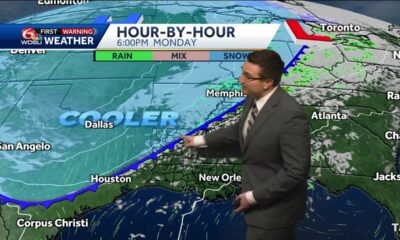News from the South - North Carolina News Feed
Here’s what I learned from this election — and it’s not all doom and gloom • Asheville Watchdog
From what I hear, we had an election last week.
A big ‘un. A humdinger, game changer, end of the world, etc., etc.
Yeah, from a Democrat’s perspective, it was bad. Kamala Harris lost decisively to Donald Trump, a man barren of morals who encouraged a deadly insurrection on our capital, flouted the law repeatedly, and made bullying the hallmark of his campaign.
We have learned many lessons from this election, and from Mr. Trump, but I’m not going to dwell on those today. All I’ll say is that the American people will tolerate a level of dishonesty, crass behavior and immorality previously thought disqualifying for any presidential candidate.
With Republicans heading toward control of all three branches of government, we will see a transformation of our country over the next two years that could devastate the environment, public health and yes, even consumer prices.
Shall we forever more remember that it is, indeed, the economy, stupid. And well, immigration.
But let’s move on. It’s not all doom and gloom for Democrats, at least on the state and local levels, partly because North Carolina has a delightful habit of going for yin and yang when it comes to elections. This time we went solidly for Trump as president but overwhelmingly for Democrat Josh Stein as governor.
And on the Council of State, Democrats won a bunch of offices: lieutenant governor, attorney general, secretary of state and superintendent of public instruction. Republicans won these: state auditor, agriculture commissioner, insurance commissioner, labor commissioner and treasurer.
“(Democrats) won half, so they gained a seat on the Council of State,” Western Carolina University political scientist Chris Cooper said last week. (I’m required by law to shoot the bull with Cooper after every major election.) “They kept the First Congressional District, which was the only competitive district in the state. They clawed back the super majority.”
“It was not a bad night for Democrats in North Carolina,” Cooper said.
Hey, we’re not blue, but we’re kind of purplish. OK, maybe mauve. Ish.
Hey, we still have two very conservative U.S. senators. But the Dems’ success on the state level remains notable.
“The song remains the same, as Led Zeppelin said,” Cooper said, referring to our dual personality and purple streak. “It’s the same story. What’s interesting or different is that some other states joined us.”
In 2020, only five Democrats won election when they were on the same statewide ballot as Trump, and four of those were in the state of North Carolina, Cooper said.
“This time, there were some Democrats who still were elected in Trump states, and it’s because he won all the battlegrounds,” Cooper said.
But let’s get back to the super-majority issue, and the governor’s veto, probably the election’s most important development.
For the past several years, Gov. Roy Cooper’s vetoes have been mostly meaningless, as the Republicans could override them at will, thanks to a super majority provided by Mecklenburg Rep. Tricia Cotham, who switched from Democrat to Republican in 2023.
Having a Democratic governor with real veto power is huge for progressives and the future of state legislation, Cooper said.

“I think the Stein victory is, of course, important, and we saw it coming,” Cooper said. “But it means so much more for the Democrats because it comes in conjunction with breaking the super majority.”
The veto is the “one legislative tool that the governor has in his toolbox, and if the Republicans had maintained the super majority, they could have overridden his veto without a single Democrat on their side,” Cooper said.
“So in practice, that means they could pass any legislation they wanted without a single Democrat agreeing,” Cooper continued. “It would have been a one-party state in terms of the legislation coming out of Raleigh.”
So, that’s pretty huge.
Another takeaway from this election is that Buncombe County is more Democratic than ever, even in the one territory Republicans made an effort to claim through favorable redistricting, House District 115, where Rep. Lindsey Prather, D-Buncombe, was the incumbent. She ran against Republican Ruth Smith, pulling out a victory with 51.4 percent of the vote.

As Cooper said, “It was close, but it wasn’t,” as Prather’s victory is safely out of recount territory.
“In that district, based on the 2020 vote, it favored the Republican Party by a few percent, so really, she outperformed her district by probably five percentage points,” Cooper said. “I think the reality is that probably means the district’s changed since 2020 — more people moving in. It’s liberalizing.”
Cooper is skeptical that another Republican will make it to the North Carolina House in Buncombe County in the foreseeable future.
On the flip side, I don’t see a Democrat going to Congress from the 11th District in my lifetime. (And yes, let’s hope that’s longer than, say, five or 10 years.) Democrat Caleb Rudow challenged incumbent Chuck Edwards, who delivered a beatdown, winning just less than 57 percent of the vote — and I thought Rudow ran a good campaign and was a very likable candidate.

Football hero Heath Shuler, a former NFL quarterback and Swain County native, was the last Democrat to hold that office, and he was essentially a Republican in many regards. Unless Shuler wants to run again, look for Edwards to stay in as long as he wants.
Speaking of beatdowns, Amanda Edwards put one on former Buncombe County Sheriff Van Duncan, who ran as an unaffiliated candidate in their race for the chair of the Buncombe County Board of Commissioners, taking 60.7 percent of the vote to Duncan’s 39.3. Duncan, a former Democrat, left the party after he said it essentially left him by drifting too far left.
Edwards hammered Duncan on his acceptance of a $125,000 retirement payout or retention bonus (depending on your point of view). But I don’t think that’s what did in Duncan, who was a highly popular sheriff.

I think what got him is he ran as an unaffiliated candidate in a very Democratic County and didn’t have any party backing.
Cooper has written a lot about unaffiliated candidates and how they have a steep uphill battle in North Carolina, first to even get on the ballot and then to actually win.
“It just shows unaffiliated candidates can’t win,” Cooper said. “Four years, maybe two years from now, we’ll have another person read ‘Don Quixote’ and start tilting at windmills.”
“He was the best possible unaffiliated candidate and he didn’t come close,” Cooper said.
Which brings me to the end of today’s column.
Let’s start talking about that 2028 race! I can’t wait for the text messages to start!
[Correction: An earlier version of this column misidentified the House district in which Rep. Lindsey Prather, D-Buncombe, was the incumbent and the victor. It is District 115. The column also misstated Chuck Edwards’s percentage of the vote total in his race against Caleb Rudow. He won just less than 57 percent.]
Asheville Watchdog is a nonprofit news team producing stories that matter to Asheville and Buncombe County. John Boyle has been covering Asheville and surrounding communities since the 20th century. You can reach him at (828) 337-0941, or via email at jboyle@avlwatchdog.org. The Watchdog’s local reporting during this crisis is made possible by donations from the community. To show your support for this vital public service go to avlwatchdog.org/support-our-publication/.
Related
The post Here’s what I learned from this election — and it’s not all doom and gloom • Asheville Watchdog appeared first on avlwatchdog.org
News from the South - North Carolina News Feed
Two women killed and several children hurt in Johnston County crash
SUMMARY: Two women in their 20s died in a car crash in Johnson County, with six children aged under 12 also in the vehicle; one child is in critical condition. The single-car accident occurred at the intersection of Government and Jack roads in Clayton. Investigators report that the driver, speeding about 30 mph over the limit and running a stop sign, lost control, hitting a ditch and a tree before the Jeep Cherokee went airborne. None of the occupants were wearing seat belts, and while alcohol isn’t suspected, the area has a history of crashes.
Two women were killed and several children were hospitalized after an SUV crashed Saturday night in Johnston County.
News from the South - North Carolina News Feed
5 On Your Side Restaurant ratings: Pure Vegan Cafe, Randy's Pizza and Chanello's Pizza
SUMMARY: Inspectors identified food handling and storage issues at several local restaurants. Pure Vegan Cafe in Durham received an 82, down from 91.5, for improper food storage, unclean equipment, and incorrect expiration dates. Randy’s Pizza in Morrisville was rated 86 (down from 94.5) due to employees failing to wash hands after handling personal items, inadequate food temperatures, and fly infestations. Chanello’s Pizza in Garner scored 88.5 (down from 91) after inspectors found expired ingredients, unclean baking trays, and a sticky fly ribbon above the prep sink. Overall, health standards were not adequately maintained across these establishments.
5 On Your Side’s Keely Arthur shows us the problems in this week’s restaurant ratings report.
News from the South - North Carolina News Feed
Man sentenced in 2018 murder of 13-year-old Hania Aguilar tries twice to escape
SUMMARY: Robinson County Sheriff Bernes Wilkins reported heightened security during prisoner Michael McLen’s court hearing. McLen, who pled guilty to the kidnapping and murder of 13-year-old Hana Aguilar and was sentenced to life in prison, made two escape attempts. He first tried using a homemade handcuff key but was stopped by deputies. Returning to prison, McLen grabbed a deputy’s gun during a struggle before being subdued with pepper spray. Eyewitnesses noted his courtroom demeanor seemed insincere, raising questions about potential additional charges from the escape attempts.
Michael Ray McLellan admitted to kidnapping 13-year-old Hania Aguilar from her driveway and then killing her and disposing of her body. The crime happened in November 2018. On Friday, November 22, 2024, he was sentenced to life in prison without the possibility of parole. Investigators say McLellan tried twice to escape from his prison guards — before and after the hearing.
https://abc11.com/post/hania-aguilar-michael-mclellan-guilty-nc-kidnapping-murder-13-year-old-girl-lumberton/15573797/
https://abc11.com/watch/live/11065013/
Download: https://abc11.com/apps/
Like us on Facebook: https://www.facebook.com/ABC11/
Threads: https://www.threads.net/@abc11_wtvd
Instagram: https://www.instagram.com/abc11_wtvd/
TIKTOK: https://www.tiktok.com/@abc11_eyewitnessnews
-

 Kaiser Health News6 days ago
Kaiser Health News6 days agoA Closely Watched Trial Over Idaho’s Near-Total Abortion Ban Continues Tuesday
-

 Local News5 days ago
Local News5 days agoSherral’s Diner to be featured on America’s Best Restaurants
-

 News from the South - Georgia News Feed4 days ago
News from the South - Georgia News Feed4 days agoJose Ibarra found guilty in murder of Laken Riley | FOX 5 News
-

 News from the South - Alabama News Feed5 days ago
News from the South - Alabama News Feed5 days agoTrial underway for Sheila Agee, the mother accused in deadly Home Depot shooting
-

 News from the South - Kentucky News Feed4 days ago
News from the South - Kentucky News Feed4 days agoNicholasville organization activates weather plan in response to bitter cold temperatures
-

 News from the South - Alabama News Feed3 days ago
News from the South - Alabama News Feed3 days agoJudge grants mistrial in Sheila Agee trial due to ‘unhinged juror’
-

 Local News2 days ago
Local News2 days agoIntroducing our Student Athlete of the Week: Ocean Springs’ very own Mackenzie Smith
-

 News from the South - Alabama News Feed4 days ago
News from the South - Alabama News Feed4 days agoAlabama's weather forecast is getting colder, and a widespread frost and freeze is likely by the …
























